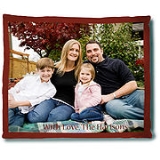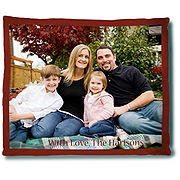
Photo blanket
Encyclopedia

Blanket
A blanket is a type of bedding, generally speaking, a large piece of cloth, intended to keep the user warm, especially while sleeping. Blankets are distinguished from sheets by their thickness and purpose; the thickest sheet is still thinner than the lightest blanket. Blankets are generally used...
, especially for warmth as a bed covering or decorative object. Photo blanket also refers to a thick cloth depicting people, objects, and symbols intended to tell a story or reveal historical events.
History
The photo blanket has a history nearly as long as the history of clothing itself. For thousands of years, people around the world used blankets as a form of communication through storytelling, honoring dead, and a well-respected form of art.Ancient Egyptians
Egyptians
Egyptians are nation an ethnic group made up of Mediterranean North Africans, the indigenous people of Egypt.Egyptian identity is closely tied to geography. The population of Egypt is concentrated in the lower Nile Valley, the small strip of cultivable land stretching from the First Cataract to...
weaved colored threads and sometimes even gold into a fabric (usually linen) or by painting with inks and dyes on papyrus
Papyrus
Papyrus is a thick paper-like material produced from the pith of the papyrus plant, Cyperus papyrus, a wetland sedge that was once abundant in the Nile Delta of Egypt....
cloth. The cloth (blanket) would often form pictures to tell stories and to honor prominent people or one of the multiple gods of their culture.
Navajo
Navajo people
The Navajo of the Southwestern United States are the largest single federally recognized tribe of the United States of America. The Navajo Nation has 300,048 enrolled tribal members. The Navajo Nation constitutes an independent governmental body which manages the Navajo Indian reservation in the...
tribes used special indigo dye
Indigo dye
Indigo dye is an organic compound with a distinctive blue color . Historically, indigo was a natural dye extracted from plants, and this process was important economically because blue dyes were once rare. Nearly all indigo dye produced today — several thousand tons each year — is synthetic...
from Mexico and other vegetal dyes to color multi-ply yarns and weave them into three main types of blankets - a serape (a shoulder covering blanket that is longer than it is wide), a saddle blanket
Saddle blanket
The terms saddle blanket, saddle pad and saddle cloth refer to blankets, pads or fabrics inserted under a saddle. These are usually used to absorb sweat, cushion the saddle, and protect the horse's back. Saddle blankets have been used for many centuries with all types of saddles...
(a blanket that was folded in half under a horse’s saddle for extra cushioning), and a chief's blanket (a shoulder blanket that was made wider than it was long).
Nepalese
Nepali people
Nepali people can refer to:*People of Nepal*Ethnic Nepalis of Indian citizenry residing in Gorkhaland area of West Bengal, Sikkim, Assam, Meghalaya, Mizoram and other parts of India.* Indian Gorkhas*Lhotshampas of Bhutan.*Nepali diaspora the world over....
rug makers - one of the most respected jobs in their society - would use luxurious silks, wools, and hemp to create beautiful works or art. Using vertical looms and fibers dyed with natural vegetal dyes
Natural dye
Natural dyes are dyes or colorants derived from plants, invertebrates, or minerals. The majority of natural dyes are vegetable dyes from plant sources – roots, berries, bark, leaves, and wood — and other organic sources such as fungi and lichens....
, they form several different types of knots together for a soft and evenly tufted finish .
For hundreds of years, tribes throughout Indonesia
Indonesia
Indonesia , officially the Republic of Indonesia , is a country in Southeast Asia and Oceania. Indonesia is an archipelago comprising approximately 13,000 islands. It has 33 provinces with over 238 million people, and is the world's fourth most populous country. Indonesia is a republic, with an...
and Africa
Africa
Africa is the world's second largest and second most populous continent, after Asia. At about 30.2 million km² including adjacent islands, it covers 6% of the Earth's total surface area and 20.4% of the total land area...
have used a dye and resist technique called batik
Batik
Batik is a cloth that traditionally uses a manual wax-resist dyeing technique. Batik or fabrics with the traditional batik patterns are found in Indonesia, Malaysia, Japan, China, Azerbaijan, India, Sri Lanka, Egypt, Nigeria, Senegal, and Singapore.Javanese traditional batik, especially from...
to create intricate patterns and pictures. During the past two or three centuries batik has become one of the principal means of expression of the spiritual and cultural values of Southeast Asia. Once again used as a form of storytelling and passing down history, picture fabrics and blankets have been an integral part of their culture.
Asian cultures
Culture of Asia
The culture of Asia is human civilization in Asia. It features different kinds of cultural heritage of many nationalities, societies, and ethnic groups in the region, traditionally called a continent from a Western-centric perspective, of Asia...
have used weaving and blankets for the same purposes, using gold and other precious metals woven into their cloths and blankets. As an important artistic form, it conveys the history and myths of a culture through iconography
Iconography
Iconography is the branch of art history which studies the identification, description, and the interpretation of the content of images. The word iconography literally means "image writing", and comes from the Greek "image" and "to write". A secondary meaning is the painting of icons in the...
and pictures.
Throughout history, photo blankets have been an ever present and fundamental key to communication, decoration, and tradition. Today’s photo blankets have changed to modern techniques and more efficient manufacturing, but the primary meaning has remained very similar. People display meaningful photos that represent memories and reveal history. Adding text or symbols communicate language
Language
Language may refer either to the specifically human capacity for acquiring and using complex systems of communication, or to a specific instance of such a system of complex communication...
and add to the blanket’s storytelling aspect.
Uses
Photo blankets are used throughout the home for displaying pictures and images as objects of decor, for warmth, or to be given and received as gifts.Uses in home decor include furniture coverings and as decorative displays of a design or photograph
Photograph
A photograph is an image created by light falling on a light-sensitive surface, usually photographic film or an electronic imager such as a CCD or a CMOS chip. Most photographs are created using a camera, which uses a lens to focus the scene's visible wavelengths of light into a reproduction of...
. Photo blankets can be used to cuddle up for warmth either in or outdoors. They are often given as wedding, birthday, Christmas
Christmas
Christmas or Christmas Day is an annual holiday generally celebrated on December 25 by billions of people around the world. It is a Christian feast that commemorates the birth of Jesus Christ, liturgically closing the Advent season and initiating the season of Christmastide, which lasts twelve days...
, baby, or anniversary gifts to individuals or couples displaying memorable pictures, dates and quotes on them.
Types
There are three main types of photo blankets - woven photo blankets, knitted photo blankets, and dyed photo blankets.A woven photo blanket is made on a jacquard loom using digital software that scans a picture, creates a pattern and then creates a woven picture blanket using various colored yarns that interlace at 90 degree angles (see weave
Weave
Weave may refer to:*Hair weave*Mozilla Weave*Weaving...
). Woven photo blankets, comes in two varieties; an afghan photo blanket and a tapestry photo blanket. The yarn used in the weave of an afghan photo blanket is the same thickness in both horizontal and vertical directions while a tapestry photo blanket is manufactured with yarn of two different diameters. In a tapestry photo blanket the thinner of the two yarns; i.e., the warp, actually consists of 6-8 different color strands of yarn which are combined in various ways, based on a photo, to re-create the colors as accurately as possible (even black and white).
A knitted photo blanket is made by a machine that uses a similar scanning and pattern process, but instead of weaving the yarns together, knits them together in a looping technique (see knit). Often knitted photo blankets consist of limited colors due to the knitting process and the continuous thread forming loops in the process.
A dyed photo blanket is the newest type of photo blanket and is made by printing dye onto fabric from a digital image (see dye sublimation). This type allows for unlimited colors and has the sharpest picture clarity of the three.
Each process creates a permanent picture, with varying degrees of softness, color and clarity.
Trademarks
The terms photo blanket, photo blankets, photo-blanket and photo-blankets are federally-registered with the United States Patent and Trademark Office Reg. No. 3,060,423).See also
Knit, WeaveWeave
Weave may refer to:*Hair weave*Mozilla Weave*Weaving...
, Dye Sublimation, Bedding
Bedding
Bedding refers to the materials laid above the mattress of a bed for hygiene, warmth, to protect the mattress, and for decorative effect. Bedding is the removable and washable portion of a human sleeping environment. It is more easily and economically replaced than the bed itself...
, History of clothing and textiles
History of clothing and textiles
The wearing of clothing is exclusively a human characteristic and is a feature of most human societies. It is not known when humans began wearing clothes...
, Textile arts
Textile arts
Textile arts are those arts and crafts that use plant, animal, or synthetic fibers to construct practical or decorative objects.Textiles have been a fundamental part of human life since the beginning of civilization, and the methods and materials used to make them have expanded enormously, while...

